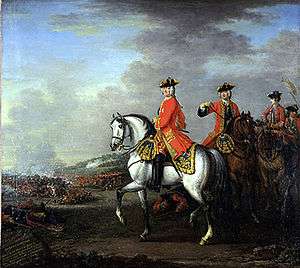John Wootton


John Wootton (ca. 1682–1764) was an English painter of sporting subjects, battle scenes and landscapes, and illustrator.
Life
Born in Snitterfield, Warwickshire (near Stratford-upon-Avon), he is best remembered as a pioneer in the painting of sporting subjects – together with Peter Tillemans and James Seymour[1] – and was considered the finest practitioner of the genre in his day. As such, his paintings were very fashionable and were sought after by those among the highest strata of the British society. These included figures such as George II of Great Britain, Frederick, Prince of Wales, and the Duke of Marlborough.
He was active from about 1714 to his death in 1764/5, based in the capital of English horse racing at Newmarket, and producing large numbers of portraits of horses and also conversation pieces with a hunting or riding setting. He had begun life as a page to the family of the Dukes of Beaufort, who in the 1720s sent him to Rome, where he acquired a classicising landscape style based on that of Gaspard Dughet, which he used in some pure landscape paintings, as well as views of country houses and equine subjects. This introduced an alternative to the various Dutch and Flemish artists who had previously set the prevailing landscape style in Britain, and through intermediary artists such as George Lambert, the first British painter to base a career on landscape subjects, was to greatly influence other British artists such as Gainsborough.[2]
He is now somewhat eclipsed in the field of animal paintings by the later George Stubbs (1724–1806), who is considered technically superior. John Wootton died in London on 13 November 1764. Examples of his animal painting can be found in the Tate Gallery, London, the Virginia Museum of Fine Arts, Richmond, the Yale Center for British Art, and in the Elizabethan Great Hall at Longleat.
See also
| Wikimedia Commons has media related to John Wootton. |
Notes
References
- Waterhouse, Ellis (1978). Painting in Britain, 1530-1790 (4th Edn ed.). Penguin Books: Yale History of Art series. ISBN 0-300-05319-3.
- Meyer, Arline (1984). John Wootton: Landscape and Sporting Art in Early Georgian England. Kenwood House, London: the Iveagh Bequest.
Further reading
 Lee, Sidney, ed. (1900). "Wootton, John". Dictionary of National Biography. 62. London: Smith, Elder & Co. p. 440.
Lee, Sidney, ed. (1900). "Wootton, John". Dictionary of National Biography. 62. London: Smith, Elder & Co. p. 440. - Harrington, Peter (1993). British Artists and War: The Face of Battle in Paintings and Prints, 1700-1914. London: Greenhill.